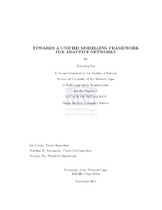| dc.description.abstract | Adaptive networks are complex networks with nontrivial topological features and connection patterns between their elements which are neither purely regular nor purely random. Their applications are in sociology, biology, physics, genetics, epidemiology, chemistry, ecology, materials science, the traditional Internet and the emerging Internet of-Things. For example, their applications in sociology include social networks such as Facebook which have recently raised the interest of the research community. These networks may hide patterns which, when revealed, can be of great interest in many practical applications. While the current adaptive network models remain mostly theoretical and conceptual, however, there is currently no unified modelling framework for implementing the development, comparison, communication and validation of agent-based adaptive network models through using proper empirical data and computation models from different research fields. In this thesis, a unified framework has been developed that combines agent- based adaptive network models and adaptive control structures. In this framework, the control parameters of adaptive network models are included as a part of the state- topology coevolution and are automatically adjusted according to the observations obtained from the system being studied. This allows the automatic generation of enhanced adaptive networks by systematically adjusting both the network topology and the control parameters at the same time to accurately reflect the real-world complex system. We develop three different applications within the general framework for agent- based adaptive network modelling and simulation of real-world complex systems in different research fields. First, a unified framework which combines adaptive net- work models and adaptive control structures is proposed for modelling and simulation of fractured-rock aquifer systems. Moreover, we use this unified modelling framework to develop an automatic modelling tool, Fracture3D, for automatically building enhanced fracture adaptive network models of fractured-rock aquifer systems, in which the fracture statistics and the structural properties can both follow the observed statistics from natural fracture networks. We show that the coupling between the fracture adaptive network models and the adaptive control structures with iterative parameter identification can drive the network topology towards a desired state by dynamically updating the geometrical states of fractures with a proper adaptive control structure. Second, we develop a unified framework which combines adaptive network models and multiple model adaptive control structures for modelling and simulation of social network systems. By using such a unified modelling framework, an automatic modelling tool, SMRI, is developed for automatically building the enhanced social adaptive network models through using mobile-phone-centric multimodal data with suitable computational models of behavioural state update and social interaction update. We show that the coupling between the social adaptive network models and the multiple model adaptive control structures can drive the community structure of a social adaptive network models towards a desired state through using the suitable computational models of behavioural state update and social interaction update predetermined by the multiple model adaptive control structure. Third, we develop a unified framework which combines adaptive network models and support vector machine based adaptive control structures for modelling and simulation of multicast congestion in mobile ad hoc network systems. Moreover, a multicast congestion detection scheme, WMCD, has been developed for the unified modelling framework, in which the incipient congestions of group members can be predicted by using support vector machine-based prediction models and current traffic states. We show that the network’s throughput capacity is efficiently improved through using the unified modelling framework, which dynamically adjusting the group structures according to the updated congestion states of group members generated by the WMCD scheme in order to relieve the high load. | en_US |

